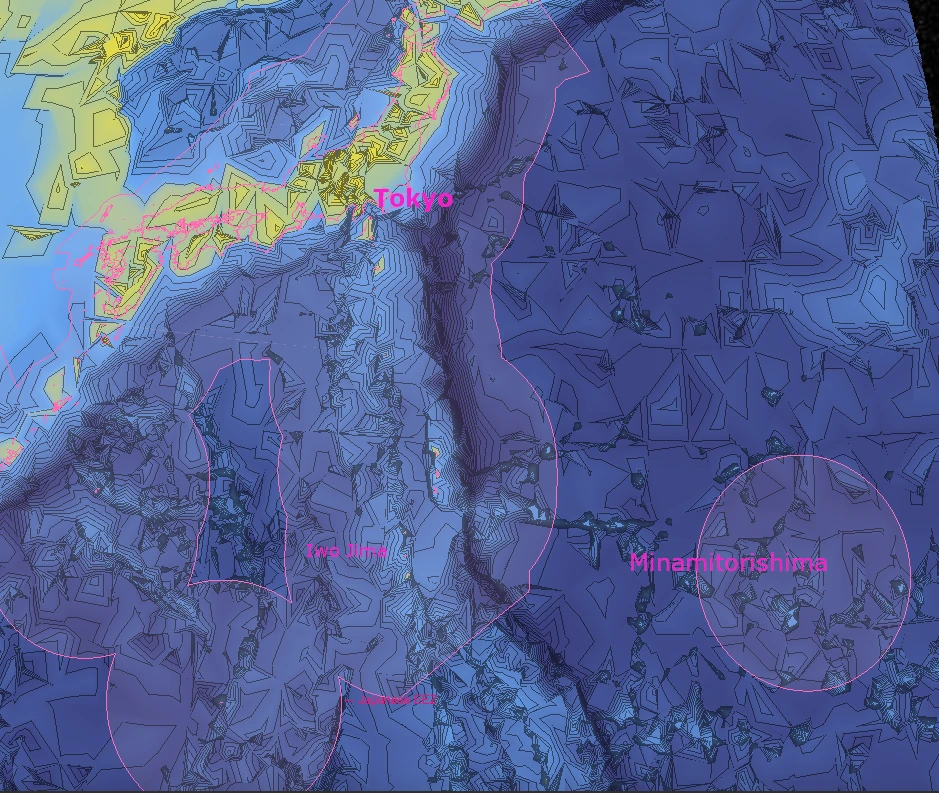Introduction
The Nippon Foundation and the School of Engineering at the University of Tokyo recently announced a large polymetallic nodule find in the Japanese Exclusive Economic Zone near Minamitorishima.
Initial reports indicated around 230 million tons of polymetallic nodules, including around 610,000 tons of Cobalt and around 740,000 tons of Nickel. Reported nodule densities are high, making this a compelling deep-sea mining opportunity for Japan.
Location
Minamitorishima Island is located approximately 1000nm (around 1150miles or 1850km) southeast of mainland Japan:
 Bathymetric map of the Japanese EEZ, including the island of Minamitorishima
Bathymetric map of the Japanese EEZ, including the island of Minamitorishima
Exploration History
Small seamounts were noticed by Oikawa and Morishita in 2009 in bathymetric survey data from the Japan Coastguard southeast of Minamitorishima Island. They noted their similarity to petit-spot volcanoes in the northwestern Pacific, which led to scientific speculation around potential subsea minerals.
In 2010, the research vessel R/V Yokosuka visited two sites in the identified area, and was able to investigate one seamount using the SHINKAI 6500 ROV. They discovered a seafloor covered in hard, round polymetallic nodules of around 5-10cm in diameter. Nodule samples were taken, which indicated Nickel, Copper and Cobalt concentrations of around 0.1-0.5%, along with high nodule densities. Research results can be found in "Geology and geochemistry of ferromanganese nodules in the Japanese Exclusive Economic Zone around Minamitorishima Island".
Deep Reach Technologies, Kiva Marine and Nippon NUS (Japan) performed subsequent surveys in April and May of 2024, which provided significantly more information on this subsea mineral resource.
2024 Survey
The most recent survey efforts were conducted by Kiva Marine's Anuanua Moana survey vessel, which typically operates out of the Cook Islands in support of Moana Minerals.
Survey samples were taken at over 100 locations, including sampling via free-fall grab and box corer, and surveying via an ROV:
Results
Survey results reveal a dense and rich nodule resource, with a high density of nodules (upwards of 30 kg/m²), along with high concentrations of Cobalt, Copper and Nickel:
- 19.5% Manganese
- 16.6% Iron
- 0.45% Nickel
- 0.37% Cobalt
- 0.24% Copper
Kriging and block-modelling of the samples reveals a compelling resource with an average density of 23 kg/m², over 60% of the area exceeding 20 kg/m², and around 30% of the area showing ultra-high nodule densities of over 30 kg/m², as seen in the plot below:
Comparison to Other Resource Plays
When compared to similar polymetallic nodule resources in the Clarion-Clipperton Zone and the Cook Islands EEZ, it is clear that the Minamitorishima resources are more comparable to those found in the Cook Islands. Nickel content is lower than in nodules found in the CCZ, but Copper and Cobalt content are both high and similar to the concentrations found in the Cook Islands EEZ:
Commercial Viability
Whilst the Nippon Federation has not made any comment on the commercial viability of this resource themselves, they have nonetheless indicated a desire to build a development consortium.
We can crudely infer the relative value of this resource play using approximate metal ore prices:
|
Clarion-Clipperton Zone |
Cook Islands EEZ |
Minamitorishima |
| Metal Ore |
Ore Price $ / ton |
Composition |
Value |
Composition |
Value |
Composition |
Value |
| Manganese: |
$650 |
27% |
$175.5 |
17% |
$110.5 |
19.5% |
$126.75 |
| Iron: |
$111 |
7% |
$7.80 |
16% |
$17.81 |
16.6% |
$18.48 |
| Nickel: |
$25,809 |
1.3% |
$335.5 |
0.4% |
$103.2 |
0.45% |
$116.1 |
| Copper: |
$8,812 |
1.1% |
$96.9 |
0.1% |
$8.8 |
0.24% |
$21.1 |
| Cobalt: |
$63,541 |
0.22% |
$139.8 |
0.4% |
$254.2 |
0.37% |
$235.1 |
Ore prices from USGS 2024 Mineral Commodity Summaries 2024
Using the metal ore price as a crude relative proxy for value, we can see that the Minamitorishima resource is similar to that of the Cook Islands, and that the majority of the value comes from the Cobalt content:
Next Steps
The Nippon Federation has put forward a series of proposals for the next steps, these include a mining demonstration test in 2025, and the formation of a consortium to develop this resource:
The proposed commercialization timeline is rapid, with a potential nodule production as soon as 2026, based upon harvester and RALS tests starting in 2025:
Summary
The resources discovered in the Japanese EEZ southeast of the remote island of Minamitorishima represent a significant subsea mineral find of polymetallic nodules.
Seafloor samples taken around May of 2024 by the Anuanua Moana research vessel indicate a resource of approximately 230 million dry tons of nodules. The nodule composition is similar to that found in nodules in the Cook Islands EEZ, with high levels of Cobalt and modest levels of Copper and Nickel. Given current ore prices and supply/demand issues, these resources are very valuable.
This resource is located in the Japanese Exclusive Economic Zone, and so it falls under Japanese jurisdiction, not under the jurisdiction of the International Seabed Authority. This means that nation-level decision making will occur - probably increasing the likelihood of an exploitation licence being granted on a far faster
The Nippon Foundation is proposing a rapid and aggressive timeline, with mining testing due to occur in 2025, and production potentially as soon as 2026. This is rapid, but given the huge value of the resource combined with Japanese political will, it seems possible, if not probable.